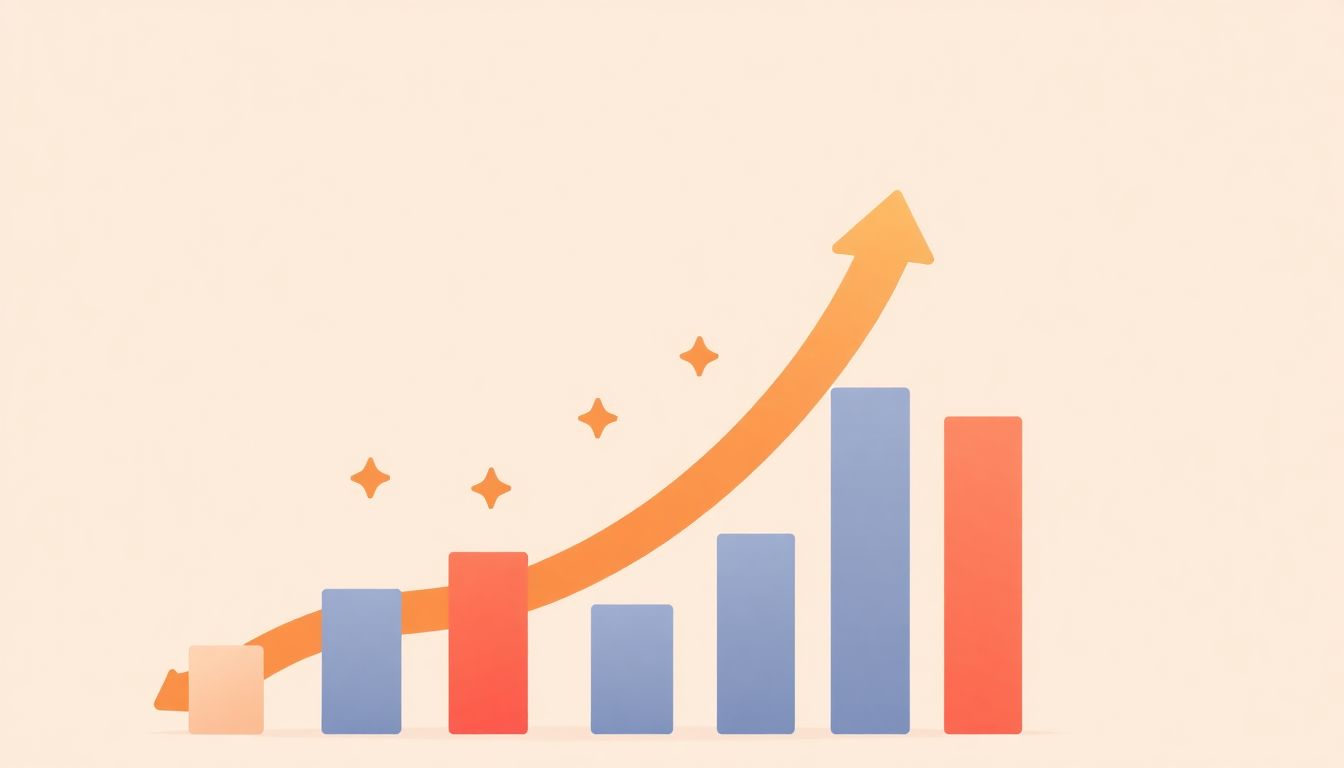Building predictive models for business forecasting can feel tough. You might feel stuck figuring out how to use ChatGPT effectively, worried your forecasts won’t be accurate enough, or unsure where to even start. I totally get it—forecasting can feel intimidating!
But stick around, and you’ll see it’s easier than you think. I’ll show you exactly how to create smart ChatGPT prompts for forecasting sales, analyzing market trends, predicting customer behavior, budgeting, and even managing your supply chain.
Ready? Let’s get into some practical tips, common mistakes to avoid, and helpful examples to set you up for forecasting success!
Key Takeaways
- Use clear, detailed prompts in ChatGPT for effective predictive modeling in business forecasting.
- Regularly update your input data to maintain the accuracy of your sales, revenue, and inventory forecasts.
- Incorporate external factors like economic changes and competitor moves in your prompts for better predictions.
- Don’t rely solely on AI—combine ChatGPT insights with traditional analysis for a comprehensive view.
- Avoid vague inquiries; specificity greatly enhances the accuracy of the generated forecasts.
- Know common mistakes, such as neglecting updates or external variables to improve predictive accuracy.

ChatGPT Prompt to Create a Predictive Model for Business Forecasting
If you’re looking to use ChatGPT predictive analytics for your business forecasting models, starting with clear and specific prompts makes all the difference.
These aren’t your typical generic requests—think of them as concise, direct commands instructing ChatGPT exactly what data-driven forecasting you want.
Here’s a handy list of ChatGPT prompts you can copy and paste directly to generate predictive models:
- “Analyze these monthly sales figures for the past two years and create a forecast predicting monthly revenue for the next six months.”
- “Based on historical marketing spend and customer acquisition data, generate a predictive model showing expected customer growth rate over the next quarter.”
- “Using this set of product inventory movement data, provide a forecast model predicting stock replenishment cycles for the next 12 months.”
- “Forecast the revenue trends for my business based on previous holiday season sales data from the last five years.”
- “Create a data-driven predictive model to anticipate seasonal fluctuations in product demand, based on these historical monthly order quantities.”
- “Using the provided market analysis data for the past three years, generate a predictive model estimating potential sales opportunities for the next fiscal year.”
If you’re aiming to improve your predictive accuracy with AI-generated prompts, clarity and detail are your best friends here.
The more specific your input is, the better ChatGPT will be at generating useful future business predictions for your strategy.
ChatGPT Prompts for Forecasting Sales and Revenue
Accurate revenue and sales forecasting can directly affect your profitability—no pressure, right?
But don’t worry, using ChatGPT sales prompts can simplify the process and give you concrete numbers to plan around.
Here’s a quick list to copy and paste into ChatGPT, providing clear, actionable prompts for forecasting sales growth and revenue projections:
- “Using historical quarterly sales data, predict our sales growth percentage for each quarter next year.”
- “Analyze our previous six months of online and in-store sales data to estimate revenue projections for each of these channels in the next quarter.”
- “Forecast our upcoming quarter revenue by analyzing the impact of our most recent pricing strategy compared to the previous year’s performance.”
- “Identify future revenue opportunities based on current industry sales trends and our past revenue data.”
- “Analyze sales volumes by region over the past three years and forecast potential high-performing markets over the next 12 months.”
- “Based on current consumer purchasing trends and our product seasonality data, forecast our product best-sellers and estimated monthly revenues for the upcoming holiday season.”
Pro tip: Regularly updating your analysis with recent data ensures your sales forecasting stays aligned with real-time market shifts.
ChatGPT Prompts to Analyze Market Trends and Patterns
If market trend forecasting feels like guesswork, ChatGPT prompts can help you make sense of the chaos.
Instead of pouring hours into manual market trend analysis, try these straightforward commands you can enter directly into ChatGPT:
- “Identify current emerging trends in the organic food market using recent industry reports and consumer feedback.”
- “Evaluate patterns in consumer purchasing behavior over the past 12 months to predict next year’s cashless payment adoption rate.”
- “Analyze social media sentiment and public dataset reports regarding renewable energy to predict global market growth trends for solar energy over the next three years.”
- “Using the provided industry data, forecast the biggest changes businesses may expect in AI technology adoption within next year.”
- “Analyze recent competitor market moves in online fashion retail and predict upcoming industry patterns for the next two seasons.”
- “Given regional market performance data from the past two years, outline potential geographic markets that could expand significantly over the next year.”
Understanding shifts and preferences in your industry puts your business a step ahead when planning strategic moves.
And if you’re running an online business specifically, make sure to check out our detailed guide on using ChatGPT for e-commerce to boost your sales strategies even more.
ChatGPT Prompts for Forecasting Inventory and Supply Chain Needs
Considering how unpredictable logistics can be, we’d all appreciate a bit of forecasting magic for inventory and supply chains.
Using these ready-to-go ChatGPT prompts, you can optimize your inventory management forecasting and predict potential supply chain disruptions before they become urgent issues:
- “Based on historical order fulfillment lead times and demand surges, generate a predictive model to estimate inventory replenishment schedules for the next quarter.”
- “Predict potential supply chain disruptions by analyzing the provided global shipping and logistics data from the past year.”
- “Forecast our next six months of warehouse inventory capacity using historical seasonal product orders and demand peaks.”
- “Analyze the previous twelve months’ inventory stockouts and provide a predictive model for avoiding stockouts for our top-selling products.”
- “Evaluate our supplier lead time data and create a forecast predicting the optimal re-order points to maintain inventory health in the coming quarter.”
- “Assess seasonal sales data and historical inventory turnover rates to forecast the stock levels needed for peak sales periods.”
When your supply chain is predictable, so is your growth—predicting inventory needs accurately can keep customers happy and revenue steady.
Interested in more ways ChatGPT can bring efficiency to your small business? You can also check our thorough guide on ChatGPT for small businesses for additional actionable tips.

ChatGPT Prompts for Budgeting and Financial Projections
Ever felt uncertain when figuring out next year’s budget or financial goals? ChatGPT can make life easier—no more spreadsheets-induced headaches.
Just feed it these targeted, detailed prompts, and you’ll have reliable financial projections and budgeting insights in no time at all.
Here’s a set of carefully created prompts you can simply copy and paste into ChatGPT immediately:
- “Analyze our past three years of monthly operational expenses and predict budget requirements for each department for the upcoming fiscal year.”
- “Using quarterly revenue and expense data from the past two years, predict next year’s overall profitability and identify key areas where budgeting adjustments are recommended.”
- “Examine market inflation reports and our historical cost data to forecast expected budget increases for raw materials and labor costs for the next 12 months.”
- “Generate a financial projection that estimates cash flow and highlights potential shortfalls for the next six months based on current expenditure, sales pipeline, and revenue trends.”
- “Evaluate historical budget allocations and departmental returns to recommend budget redistribution for maximum profitability next fiscal quarter.”
- “Predict the financial impact on our budget if sales drop by 10% next quarter, providing potential cost-saving measures to mitigate the downturn.”
A quick tip: Include regularly updated months or quarters of data in your prompts. The more current your data inputs, the more accurate ChatGPT’s financial forecasting becomes.
ChatGPT Prompts to Predict Customer Behavior and Demand
Wouldn’t it be great to know exactly what your customers will do next? With ChatGPT, you’re one step closer to crystal-clear customer predictions (almost).
Use these straightforward prompts to anticipate customer buying behavior, trends, and demand patterns going forward:
- “Analyze our transaction history and customer profiles to forecast which customer segments are most likely to increase spending over the next quarter.”
- “Using recent customer feedback and past buying trends, predict shifts in customer demand for our top five products over the next six months.”
- “Evaluate data on customer churn rate, product reviews, and satisfaction surveys to forecast potential customer attrition and identify early signs of dissatisfaction.”
- “Create predictive insights on how pricing adjustments will affect customer buying habits based on previous pricing experiments and purchase history.”
- “Forecast seasonal demand spikes for specific customer demographics by analyzing historical demographic purchase data and product consumption patterns.”
- “Predict customer response and engagement rates for next quarter’s promotional campaigns based on marketing data from previous similar campaigns.”
Your customer prediction accuracy improves significantly when you provide clear and detailed historical context within each prompt, such as past specific periods, demographics, and campaign types.
Tips for Improving Business Forecasting Accuracy Using ChatGPT
Now, let’s be real—ChatGPT outputs are only as accurate as the details you feed it. Here are some practical tips to boost the precision of your AI-generated business forecasts:
First, always give ChatGPT accurate and specific historical data points, clearly defining periods and metrics like revenue, expenses, customer numbers, or inventory levels.
Second, ask ChatGPT to include potential factors that could dramatically impact your forecast, such as economic changes, competitor strategies, or customer trends.
For instance, your prompt could say, “Include recent inflation data and competitor price shifts to forecast next quarter’s sales trajectory.”
Third, run your models regularly with updated data; forecasting isn’t a one-and-done activity. The fresher the data, the higher quality forecasts you’ll get back from ChatGPT.
Also, don’t completely rely on AI—run parallel checks with traditional forecasting methods from time to time, then adjust accordingly to identify inaccuracies or blind spots.
Lastly, if a forecast seems way off-base, break down your query into smaller, separate prompts. Often, more narrowly focused queries can lead to more reliable predictions.
Keep these practical steps handy, and your forecasting game will stay strong, consistent, and effective with ChatGPT as your sidekick.
Common Mistakes When Using ChatGPT for Predictive Modeling
No matter how useful ChatGPT is, we’ve all stumbled into a few pitfalls at some point.
If you’re aware of these common mistakes, you’ll sidestep unnecessary confusion—and better yet, avoid inaccurate predictions:
Mistake #1: Not being specific enough. If your prompt is vague, you’ll get generalized results, like saying “predict our sales” rather than specifying “using last year’s holiday season data, predict monthly sales for the next season.”
Mistake #2: Forgetting important external variables. External factors like market conditions, competitor moves, or economic shifts can drastically alter your forecasts. Include them explicitly in your prompts.
Mistake #3: Expecting perfection right away. ChatGPT improves as you refine your prompts. Don’t just accept the first reply; iterate with follow-up questions or refined prompts to clarify ambiguous outputs or drill down into valuable insights.
Mistake #4: Sole reliance on AI. While ChatGPT is handy, blend AI forecasts with traditional analytics to confirm results. Your intuition—and past experiences—should still hold value.
Mistake #5: Not updating ChatGPT predictions regularly enough. Market conditions rapidly shift, and outdated forecasts won’t catch sudden changes. Re-run your prompts regularly with fresh data for ongoing usable forecasts.
Keep these common slip-ups in mind, and your business predictions using ChatGPT will stay on track and actionable.

Examples of Effective Business Forecasting Prompts for ChatGPT
If you’ve made it here, you’re probably wondering about solid, no-fluff examples of ChatGPT prompts to help with your business forecasting.
Using prompts that specifically tell ChatGPT what you’re looking for means you’ll get clear, actionable results without wasting time.
I’ve hand-picked a few more examples you can copy right now and paste directly into ChatGPT for your forecasting needs:
- “Analyze the attached 12-month customer return rates and predict customer retention figures for the next quarter.”
- “Assess historical seasonal discounts and their impacts on sales revenue, then forecast results if we offer a 15% discount next season.”
- “Predict sales revenue impact if we introduce premium product lines based on historical customer spend in related product categories.”
- “Use past quarterly data to forecast how different marketing budget allocations could impact customer acquisition in the next two quarters.”
- “From inventory turnover data of our five leading products, forecast which products might face shortages in the upcoming holiday period.”
- “Based on past years’ expense data and inflation trends, create a model predicting operational costs for each department next year.”
As you see, the magic is in giving precise context: ChatGPT responds to specific scenarios clearly and helpfully, boosting your forecasting accuracy.
Don’t hesitate to adjust the timelines, products, or situation details to fit your specific business data; that’s how you refine and get better predictions.
FAQs
ChatGPT can assist in forecasting sales, revenue, inventory, market trends, budgeting, and customer behavior. By providing relevant data and context, it generates tailored predictive models to meet your specific business needs.
To improve accuracy, provide detailed input data, refine your prompts for clarity, and review generated insights against historical performance. Iteratively adjust your queries based on outcomes for even better results.
Common mistakes include providing vague prompts, neglecting historical data, and failing to validate outputs with external data sources. Be specific and thorough in your requests for more reliable insights.
Yes, ChatGPT can identify and analyze market trends by interpreting data patterns and consumer behavior. By asking targeted questions, you can leverage its capabilities to gain meaningful insights into market dynamics.
